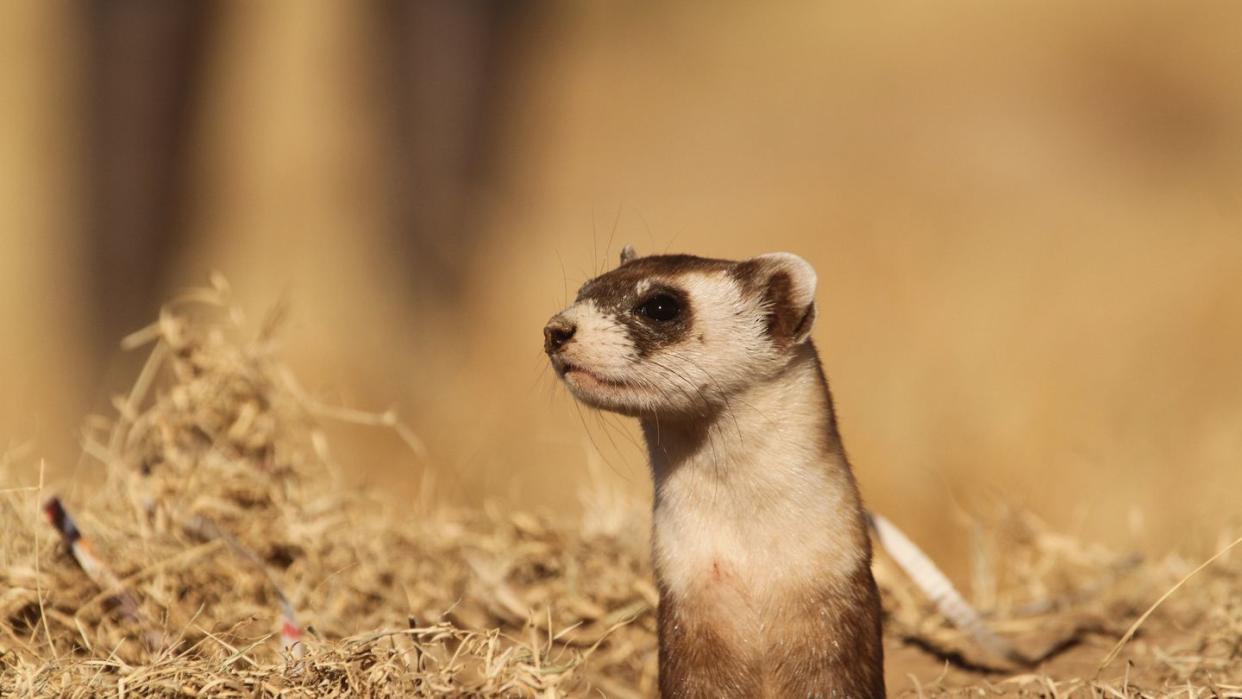A Ferret Died in 1988 and Spawned 3 Clones. Now, They Could Save Their Entire Species.

In 2020, the black-footed ferret became the first endangered species in North America to be cloned in an effort to increase its vulnerable numbers.
Now, the U.S. Fish and Wildlife Service, in partnership with a biotechnology nonprofit, is announcing that it’s followed up that initial cloning effort with two more ferrets born from the same genetic material.
While this is good news for the black-footed ferret, the species still has a long way to go before it can be considered stable in the wild.
Using extreme means to save vulnerable animals from the threat of extinction is as old as the parable of Noah and the Ark — but in the 21st century, science has made conservation efforts a more sophisticated affair. One of the most prominent examples in North America is that of the black-footed ferret (Mustela nigripes), a native resident of the Great Plains.
At the absolute nadir of the species’ existence, only seven breeding individuals were thought to be alive in the wild—in fact, the number was so low that scientists actually thought the animal was extinct until it was rediscovered in 1981. But through the steady conservation efforts by the U.S. Fish and Wildlife Service (USFWS) as well as other organizations, that number has steadily grown to around 300. Captive breeding and habitat protections have gone a long way to help protect this endangered mammal, but this conservation effort has also relied heavily on cloning.
In 2020 the biotechnology non-profit Revive & Restore, in partnership with the USFWS and San Diego Zoo Global, successfully cloned a black-footed ferret (named Elizabeth Ann) from material stored at the San Diego Frozen Zoo. Now, the USFWS announced that it’s followed up that cloning milestone—the first clone of an endangered species in North America—with two more clones, Noreen and Antonia.
All three ferrets were cloned from the same tissue sample collected in 1988 and stored at the San Diego Frozen Zoo, a genetic repository of 10,000 cell cultures of some 1,000 taxa. The idea is the fauna equivalent to the Svalbard Global Seed Vault with the capacity to store 4.5 million varieties of plants. The Frozen Zoo is currently playing a star role in the massive undertaking to save the effectively extinct northern white rhino, but it’s importance can clearly be seen in the USFWS’s efforts to save the black-footed ferret.
This ferret species experienced a genetic bottleneck of only seven breeding individuals, limiting the population’s genetic diversity and causing diseases like sylvatic plague and canine distemper. Because Elizabeth Ann, now joined by Noreen and Antonia, come from samples containing three times more genetic variation, according to the USFWS, this influx of genes into the existing population will hopefully spawn more genetic diversity.
This conservation plan hit a slight speed bump as the USFWS reports that Elizabeth Ann suffers from a condition known as hydrometra, so breeding this cloned ferret has been unsuccessful. However, they also note that this condition occurs in other black-footed ferrets, so it’s likely not related to the cloning process itself. Otherwise, Elizabeth Ann appears to be a happy and healthy black-footed ferret displaying “typical adult ferret behavior.” It’s uncertain if Noreen and Antonia will meet a similar fate, but the USFWS says they will continue providing updates on their development.
One of the most endangered mammals in North America, the path to a full recovery of the black-footed is a long and winding road as the population needs to reach around 3,000 breeding adults—ten times its current amount. And while cloning and captive breeding are helping this small population, other efforts like habitat restoration and protection are just as important. After all, it doesn’t help much to save a species only for it to have nowhere to go.
Captive breeding, habitat restoration, and cloning is a much better way to save a species than shoveling animals onto a mythical boat two-by-two (talk about genetic bottlenecks!), but survival of the black-footed ferret as well as other endangered mammals locked away in the Frozen Zoo is far from certain.
You Might Also Like


